For Myanmar’s Army, Ethnic Bloodletting Is Key to Power and Riches
ASIA--PACIFIC, 5 Feb 2018
Richard C. Paddock – The New York Times
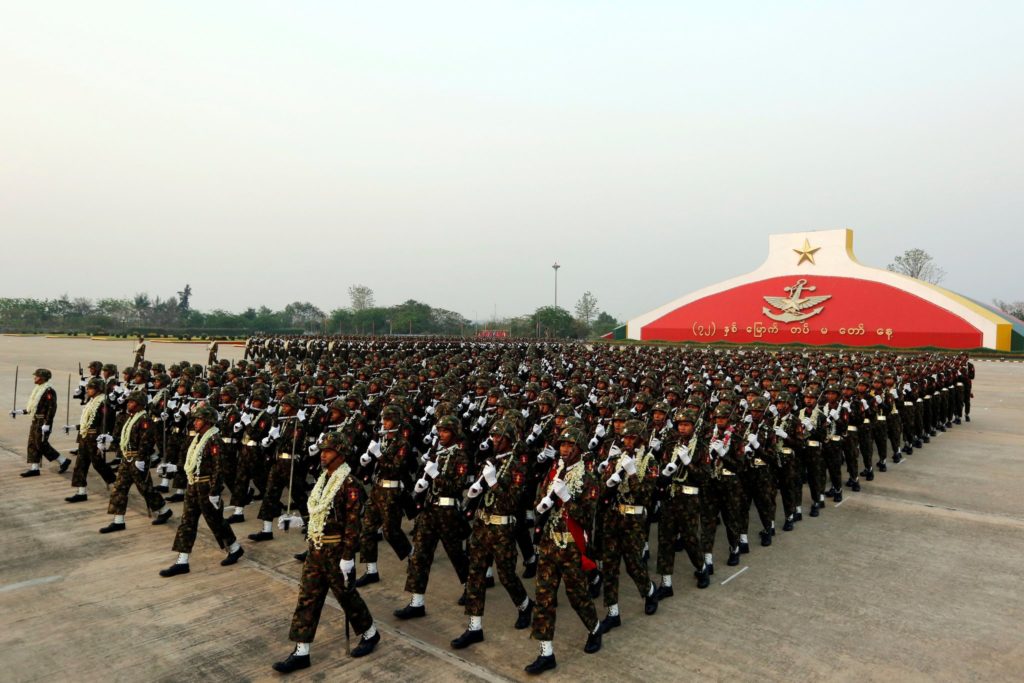
A military parade in Myanmar’s capital, Naypyidaw, in March. The army has spent most of the past seven decades warring with its own people. Credit Soe Zeya Tun/Reuters
27 Jan 2018 – For Myanmar’s army, the campaign of atrocity it has waged to drive hundreds of thousands of ethnic Rohingya Muslims out of the country is no innovation. The force was born in blood 76 years ago and has been shedding it ever since.
Its founders, known as the Thirty Comrades, established the army in 1941 with a ghoulish ceremony in Bangkok, where they drew each other’s blood with a single syringe, mixed it in a silver bowl and drank it to seal their vow of loyalty.
The army they formed led the nation to independence in 1948. But except for a brief, initial period of peace, it has spent the past seven decades warring with its own people.
The army, known as the Tatmadaw, seized power from the civilian government in Burma, as the country is also known, in 1962. It killed thousands of protesters to keep power in 1988 and suppressed another popular uprising, the Saffron Revolution, in 2007.
In constant fighting with ethnic minorities, the Tatmadaw has displaced millions of people while taking billions of dollars in profit from jade mines, teak forests and other natural resources. Its strategy has been to fight ethnic rebels to a standstill, manage the conflicts through cease-fires and enrich its officers.
“There has never been any sense of needing to win hearts and minds,” said Zachary Abuza, a professor at the National War College in Washington. “The Tatmadaw’s doctrine is based on total submission by the population through fear. And to that end, there is little they will not do.”
Though it holds itself up as the protector of Myanmar’s people, the military has a long history of murdering civilians, torturing and executing prisoners, committing rape, conscripting child soldiers, impressing convicts as porters and making civilians walk ahead of its troops to trip land mines.
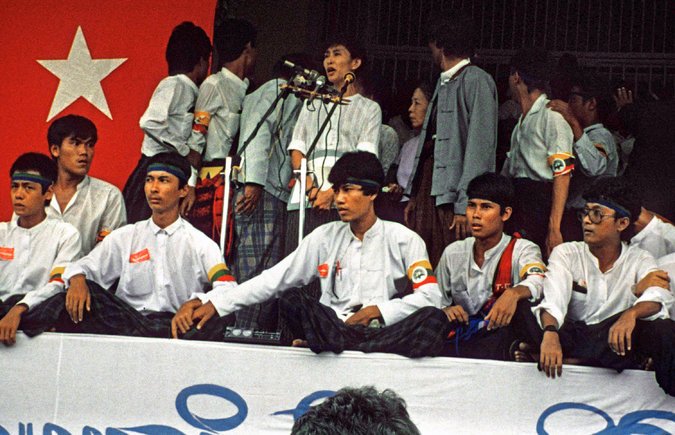
Aung San Suu Kyi addressing an antimilitary rally in Yangon, Myanmar’s largest city, in 1988. The army killed thousands of protesters that year to keep power.
Credit Agence France-Presse — Getty Images
After decades of running an isolated pariah state, the military began loosening its grip in 2010, allowing elections and gradually giving civilian leaders authority over public services, foreign affairs and economic policy. It also permitted public access to the internet and the sale of cellphones.
The moves, aimed at reviving a struggling economy, gave Myanmar a veneer of democracy and prompted the United States and the European Union to lift economic sanctions.
But under the constitution it imposed in 2008, the Tatmadaw is not subject to civilian authority and retains control over other key institutions, including the police and border guards, and it unilaterally appoints a quarter of the Parliament. And the atrocities against minorities continue.
“The Tatmadaw is an unreconstructed, unrepentant institution that is abusive to its core,” said David Mathieson, an independent analyst in Yangon.
The violent expulsion of the Rohingya from Rakhine has been condemned as ethnic cleansing by the United States and the United Nations. Human rights advocates have called for the International Criminal Court at The Hague to investigate the Tatmadaw for crimes against humanity.
The military and the government have blocked independent investigations and kept neutral observers from visiting the area, even as the Tatmadaw’s commander in chief, Snr Gen Min Aung Hlaing, denied that the army committed atrocities against the Rohingya.
But there are signs the military is feeling at least some pressure.
Snr Gen Min Aung Hlaing acknowledged this month that four members of the security forces shot 10 Rohingya men whose bodies were found in a mass grave.
Two officials who oversaw the security forces in Rakhine, Maj Gen Maung Maung Soe, head of the Tatmadaw’s western command, and Brig Gen Thura San Lwin, the border guard commander there, were removed from their positions without explanation.
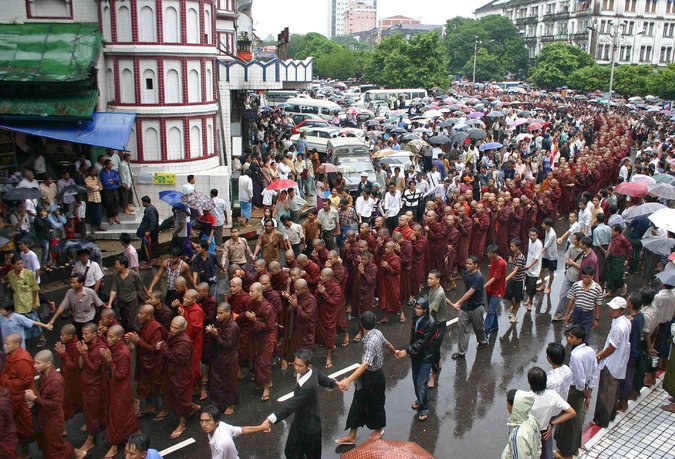
Buddhist monks marching in Yangon during the Saffron Revolution in 2007, another popular uprising suppressed by the military. Credit Agence France-Presse — Getty Images
Washington imposed sanctions on Maj Gen Maung Maung Soe in December, freezing any assets he might have in the United States. It is unclear whether the penalties will affect him, and so far, he is the only Myanmar official the United States has sanctioned over the Rohingya expulsion.
The Tatmadaw is proud of its history, which it glorifies with a colossal museum near Nay Pyi Taw, the capital.
One exhibit recreates the setting of the blood oath ceremony and displays what are said to be the bowl and syringe used by the Thirty Comrades.
The comrades named their militia the Burma Independence Army and gave command to their leader, Aung San, who is regarded as the father of the country (and was the father of Myanmar’s current civilian leader, Aung San Suu Kyi).
The Thirty Comrades went to Japan for military training and fought against Britain during most of World War II, but they switched sides after it became clear the British would win.
Aung San became premier of the British colony but was assassinated in 1947, when Aung San Suu Kyi was 2 years old. Burma gained independence the following year.
Led by one of the comrades, Gen Ne Win, the Tatmadaw seized power from a civilian government in 1962. After pro-democracy protests erupted in 1988, he was ousted by other generals. The Tatmadaw killed an estimated 3,000 protesters but maintained control of the government.
For nearly half a century, the military government kept the country isolated. It imprisoned political opponents for years, intermittently closed universities and denied the population access to the internet. Suu Kyi, who led the opposition and received the 1991 Nobel Peace Prize, spent 15 years under house arrest.
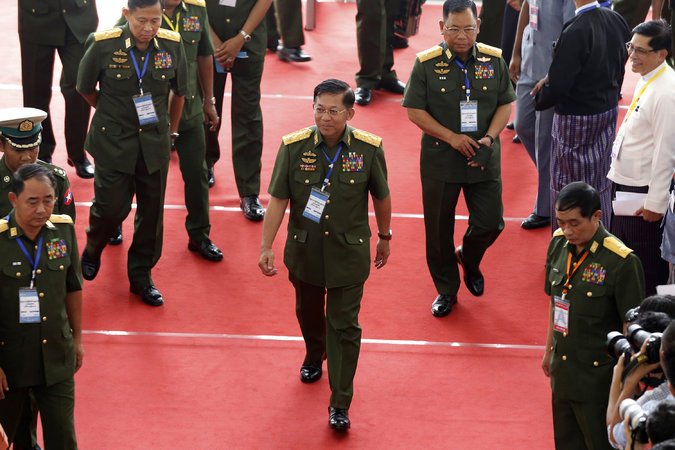
Senior Gen. Min Aung Hlaing, the supreme commander of the armed forces, is Myanmar’s most powerful figure and is not accountable to civilian authority.
Credit Hein Htet/European Pressphoto Agency
There was no attempt to create a cult of personality around its leaders, but the Tatmadaw became the country’s only viable institution, with separate schools and hospitals, a judicial system and a network of businesses.
“The military is a state within the state,” said U Ye Myo Hein, executive director of the Tagaung Institute of Political Studies, an independent policy centre in Yangon.
The Tatmadaw academy’s motto is “The triumphant elite of the future.” Triumphant or not, the generals took a nation that was one of the wealthiest in Southeast Asia and, over six decades, transformed it into one of the poorest.
By 2010, they had little choice but to open the country to the outside world, seek foreign investment and begin relinquishing control over the economy. But the constitution they imposed includes safeguards for the military.
For one, it grants immunity to the Tatmadaw for crimes committed before the government handover in 2011. The military also retains sole authority to investigate itself, and military courts have jurisdiction over its personnel.
“Military impunity severely undermines the rule of law in Myanmar,” said Sean Bain, a legal adviser with the International Commission of Jurists in Yangon.
In its latest campaign against the Rohingya Muslims in northern Rakhine state, which has no notable resources to extract, there still has been a tangible gain for the military: a nationalist victory for a force that casts itself as the champion of the country’s ethnic Bamar Buddhist majority.
The Tatmadaw’s ranks are dominated by the same Bamar ethnic group that makes up about two-thirds of Myanmar’s population, and the force has kept Bamar nationalism as its central value.
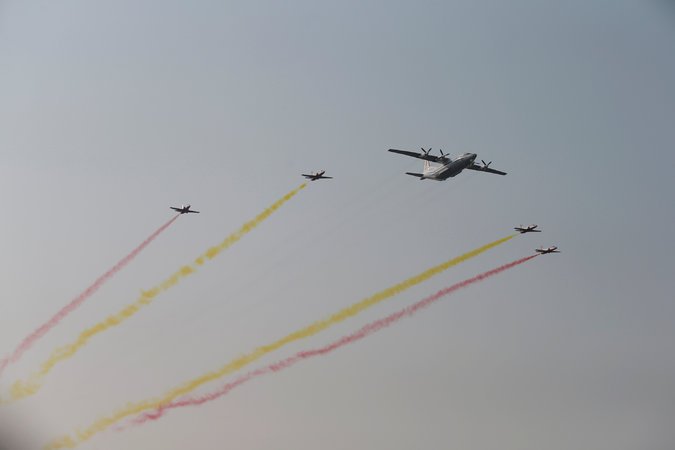
An air show on Myanmar’s Armed Forces Day in March. Airstrikes have been a major component of the military’s campaign against ethnic minorities.
Credit Soe Zeya Tun/Reuters
The army’s constant warfare with ethnic minorities has also given it a business advantage. The mountainous periphery of the country that is home to most of the non-Bamar people is where many valuable resources are found, including jade, gems and timber.
Soon after independence, the military began fighting other ethnic groups that sought autonomy, pushing them further into the periphery. Over the years, the Tatmadaw has battled dozens of rebel armies, often several at a time, across an ever-changing landscape of alliances, military-sponsored militias and cease-fires.
It uses a brutal anti-insurgency strategy called the “Four Cuts,” suppressing entire civilian populations to deny rebels support. The torching of villages, rape and mass killing that have been seen in the Rohingya campaign were central tactics in other fights.
Since the quasi-civilian government took office in 2011, rebel groups had been reporting about 10 armed clashes with the Tatmadaw a month. But despite efforts by civilian leaders to secure peace, the number of clashes rose sharply last year.
At the moment, the Tatmadaw is battling four ethnic groups. Fighting has intensified in recent weeks in regions controlled by the Kachin and the Shan. On Friday, four people were reported killed when the Tatmadaw air force bombed a village in Kachin state.
The United Nations estimates that more than 340,000 people uprooted by years of conflict live in camps in Myanmar and Thailand, in addition to the 737,000 Rohingya who fled to Bangladesh over the past 15 months.
The perpetual conflict creates a state of limbo in which the Tatmadaw can operate freely. In some areas, the military has seized territory that holds vast resources. In others, where it has negotiated cease-fires, it has struck deals with local groups.
With cease-fires, as opposed to peace agreements, it can argue that a military presence is still justified, and maintain firm control.
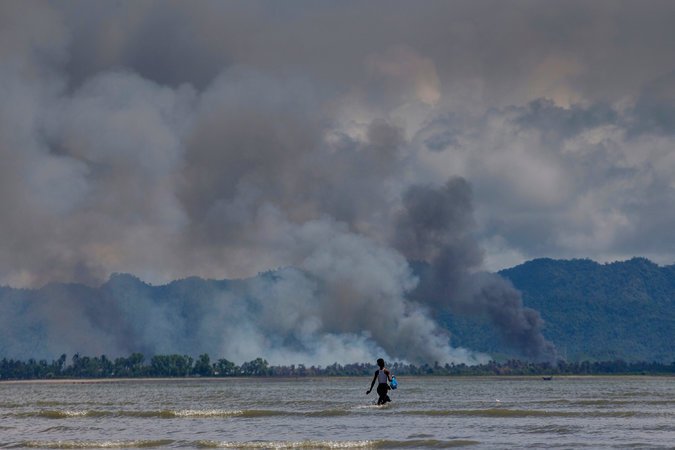
The smoke from burning Rohingya villages in Myanmar could be easily seen from Bangladesh in September. The army’s campaigns against other ethnicities have also featured methodical arson.
Credit Dar Yasin/Associated Press
Kevin Woods, a visiting scholar at the East-West Center in Honolulu, calls the Tatmadaw’s approach “cease-fire capitalism.”
The military owns two large, secretive conglomerates. A 2015 report by Global Witness, a London-based anti-corruption organisation, found that the military, its cronies and major drug lords controlled tens of billions of dollars from the jade trade in northern Kachin state. It said it could be “the biggest natural resource heist in modern history.”
Other Tatmadaw enterprises in war-ravaged regions include extracting rubies, gold, copper and timber. Ethnic groups say the military has seized land for agribusiness and for hydroelectric dams, which produce electricity sold to neighbouring China.
Stand-offs between the military and well-armed ethnic groups have created a lawless territory along the Chinese border that has become one of the world’s most lucrative drug-producing regions.
Billions of dollars’ worth of heroin and, increasingly, methamphetamine are produced there and smuggled out via roads and ports under Myanmar’s control.
“The army doesn’t want peace,” said U Win Htein, a long-time adviser to Suu Kyi and army veteran who spent 20 years in prison for opposing the government.
He noted that in 2013, then-President Thein Sein, a former general who became the new era’s first civilian leader, directed Snr Gen Min Aung Hlaing to halt offensives against ethnic groups.
“Thein Sein ordered the army to stop, but they didn’t stop,” he said. “The army is independent and no one can influence them. They don’t listen to anybody.”
________________________________________
Richard C. Paddock reports on Southeast Asia as a contributor to The New York Times, based in Bangkok, Thailand. He has worked as a foreign correspondent for more than a dozen years and reported from nearly 50 countries on five continents, including wartime Bosnia and Iraq.
A version of this article appears in print on January 28, 2018, on Page A8 of the New York edition with the headline: For Myanmar Military, Ethnic Atrocity Is Path to Power and Riches.
DISCLAIMER: The statements, views and opinions expressed in pieces republished here are solely those of the authors and do not necessarily represent those of TMS. In accordance with title 17 U.S.C. section 107, this material is distributed without profit to those who have expressed a prior interest in receiving the included information for research and educational purposes. TMS has no affiliation whatsoever with the originator of this article nor is TMS endorsed or sponsored by the originator. “GO TO ORIGINAL” links are provided as a convenience to our readers and allow for verification of authenticity. However, as originating pages are often updated by their originating host sites, the versions posted may not match the versions our readers view when clicking the “GO TO ORIGINAL” links. This site contains copyrighted material the use of which has not always been specifically authorized by the copyright owner. We are making such material available in our efforts to advance understanding of environmental, political, human rights, economic, democracy, scientific, and social justice issues, etc. We believe this constitutes a ‘fair use’ of any such copyrighted material as provided for in section 107 of the US Copyright Law. In accordance with Title 17 U.S.C. Section 107, the material on this site is distributed without profit to those who have expressed a prior interest in receiving the included information for research and educational purposes. For more information go to: http://www.law.cornell.edu/uscode/17/107.shtml. If you wish to use copyrighted material from this site for purposes of your own that go beyond ‘fair use’, you must obtain permission from the copyright owner.